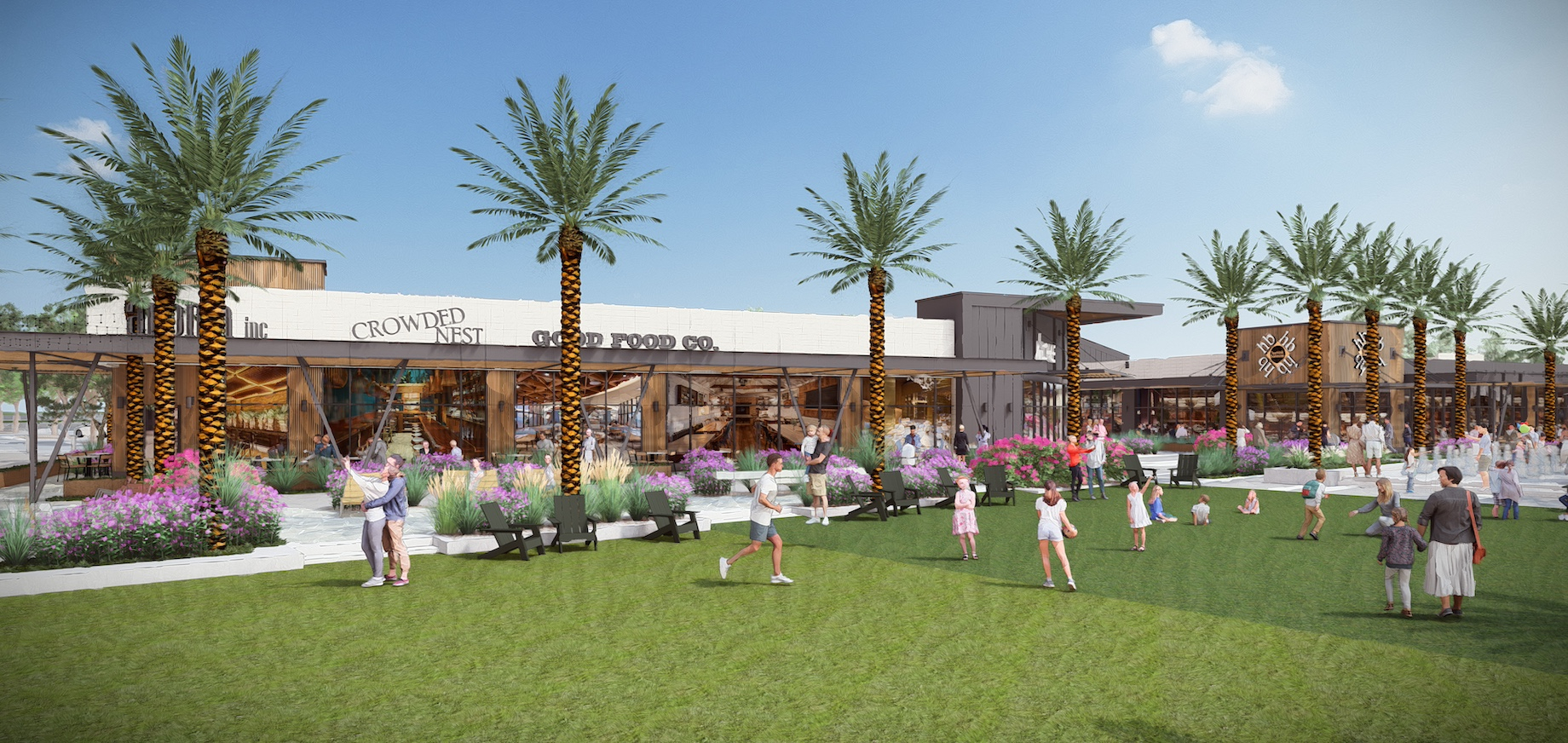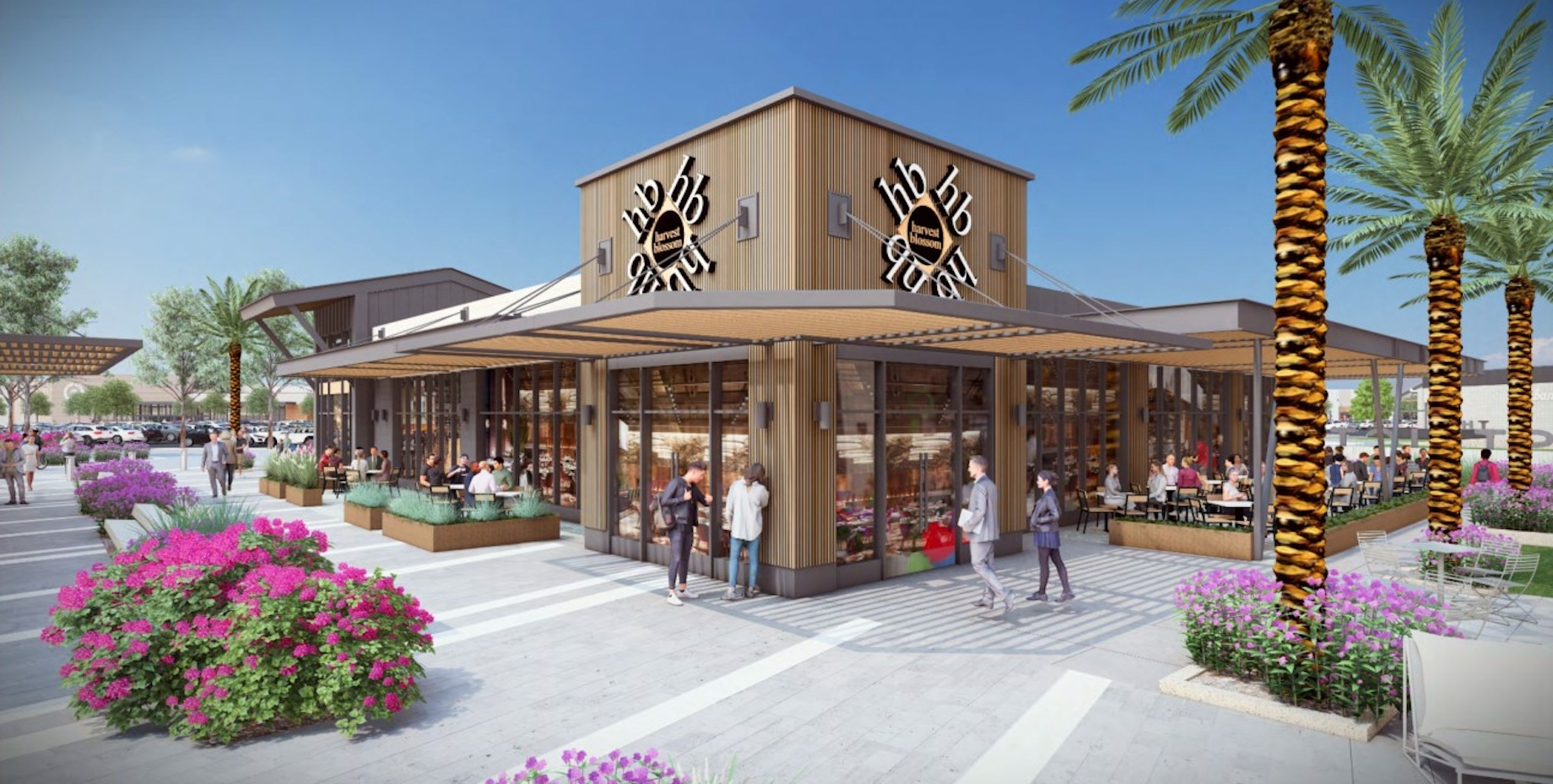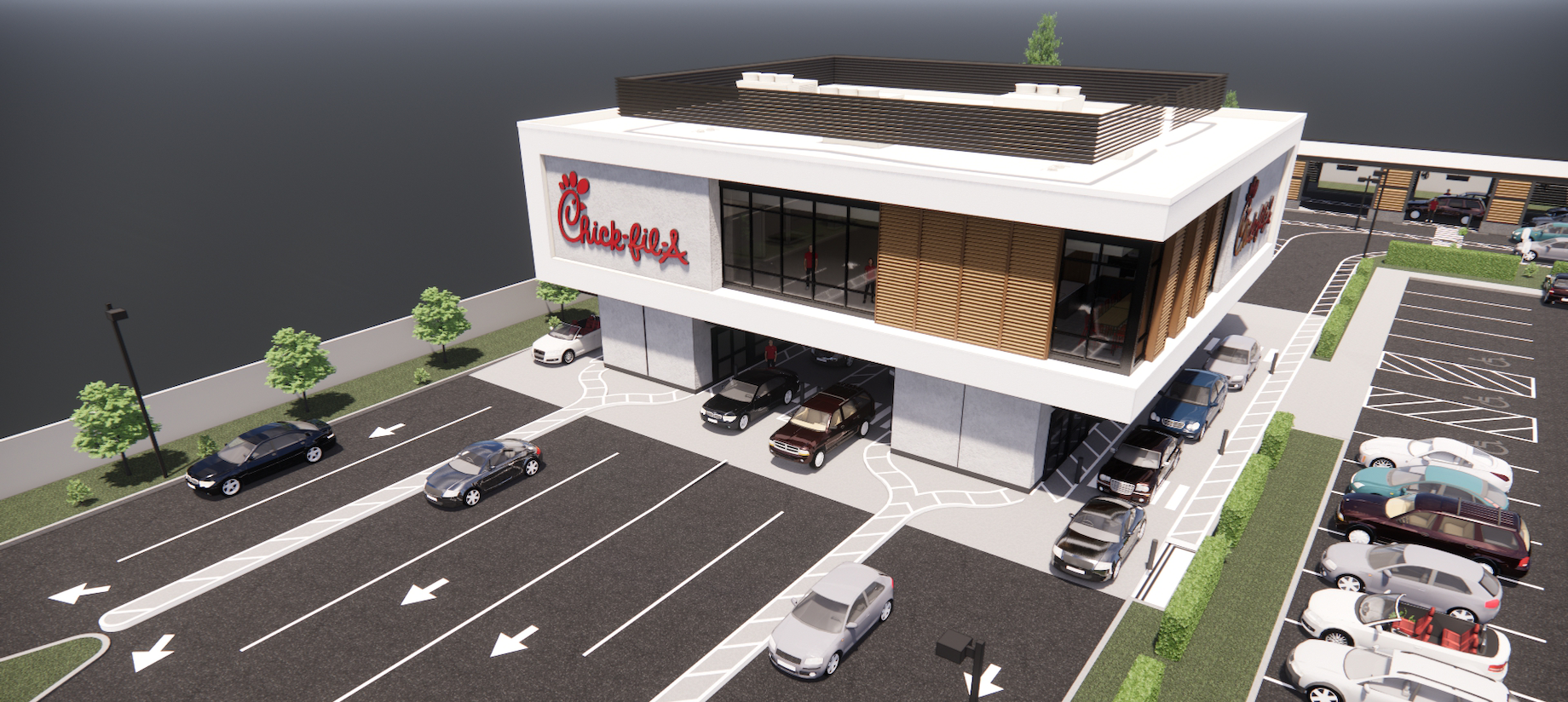Today’s ground-up open-air projects differ from those of earlier eras. The changes — including ramping up outparcel tenants, focusing less on big-box anchors and adding spacious lawns, plazas and patios — offer a glimpse into the future of lifestyle, power and even some grocery-anchored centers.
“While interest rates can have an impact on commercial real estate development, that challenging environment forces you to do things differently or more creatively,” said WMG Development executive vice president of development Craig Kopko. “It accelerates industry growth. I love to see the industry reinvent itself and improve upon the norm.”
Mall-Worthy Amenities
Based in Winter Garden, Florida, WMG has 177 developments underway this year, with a focus on grocery-anchored centers in the Sun Belt. The company’s new open-air projects “leverage experiential retail, junior-box and big-box anchors together while introducing new uses like medical, multifamily and hospitality,” Kopko said.
Adding central lawns and encircling them with patios and restaurants can be part of the mix. “Enclosed malls provided a great feeling to me growing up,” Kopko said. “You could hop around retailers who were all close together, enjoy fountains, eat, sit and relax. Now, in the open-air phase of these projects, WMG take parts of the traditional enclosed mall that I loved growing up and scatters them cohesively throughout the project.”
Generally speaking, the higher costs of land, financing and construction are leading to smaller open-air centers with fewer large-format anchors, said Retail Specialists executive vice president Bill Read. “There’s less risk in building smaller centers than the 800,000-square-foot power centers that we used to see.”
Fewer Anchors
Large lineups of anchors are giving way to more diversified approaches. “The days of having two or three large-box anchor tenants and six to eight junior anchors between them are gone,” Kopko said. “The economics for that construction and the lack of total tenant expansion no longer make those projects feasible.”
Read added that retail bankruptcies and store closures over the past couple of years have made it easier for healthy, large-format tenants to take down vacant boxes in strong centers and markets. As a result, they can be less interested in anchoring new ground-up projects. “Since August 2020, we’ve had something like 1,100 or 1,200 boxes ranging from 25,000 to 35,000 square feet added to the market, and that’s just Bed Bath & Beyond and Stein Mart,” Read noted.
For the May 2024 issue of The Read Report, he tracked more than 73 former Bed Bath & Beyond locations taken by off-price retailer Burlington. “Apparel led the charge in the most amount of uses backfilled,” Read wrote. “We tracked over 103 clothing stores opening in BBBY spaces. While Burlington was the most aggressive, Nordstrom Rack took 11, Sierra Trading six and Ross five.”
Continuity, With a Twist
But market dynamics are a huge factor when it comes to open-air tenant mixes. A power center slated for a new, high-growth suburb or exurb might enjoy enough breathing room and tenant demand to resemble a counterpart from 15 years ago. “Even in California, the edge suburbs still need centers anchored by The Home Depot, Ross or Staples,” said architect Sean Slater, senior principal at RDC. Nonetheless, construction of massive power centers with multiple big-box anchors “is a fraction of what it was. … The only place where we’re seeing those continue to develop are new suburbs and freeway extensions.”
Continuity with the past is part of the picture for some of the open-air projects Vestar is building in the still-expanding Phoenix metro. These ground-up developments include smaller power centers, as well as outdoor shopping, dining and entertainment destinations like Verrado Marketplace that can be as large as 500,000 square feet. They boast anchors like Target, Costco, Safeway, Marshalls, Ross Dress for Less and HomeGoods. “We’re coming out of the ground with centers now that do share some similarities to projects that we did 10 or 15 years ago, but there are definitely differences and nuances,” said Vestar executive vice president of development Jeff Axtell.

Vestar’s Verrado Marketplace in Phoenix, also pictured at top, is set to be anchored by Target, Harkins BackLot family entertainment center, Safeway, Marshalls, Ross Dress for Less and HomeGoods by 2026. …

… But while it boasts plenty of big-box retail, the 500,000-square-foot center departs from the traditional power center model, offering a central lawn, entertainment district, outdoor patios and other amenities.
MORE FROM C+CT: 9 Big Phoenix Retail Developments After 15 Years of Nothing
Some of those differences began to emerge in the COVID era, he said. They include things like:
- A stronger focus on outdoor gathering areas. “People want to be outside, particularly in Phoenix where the weather is nice most of the year,” Axtell explained. These larger gathering spaces allow Vestar to offer “concerts and holiday events and give that space to the surrounding neighborhoods as their space.” More common areas also can create specialty leasing opportunities, a trend that some say will accelerate.
MORE FROM C+CT: How Regency Centers’ Pilot With Short-Term-Leasing Tech Provider Spacewise Works
- More robust restaurant lineups, with bigger and better patios. “The patios are getting larger than they used to be,” Axtell said. “They’re also becoming more all-weather, with better shade structures and misting systems, as well as music, to create that vibe.”

A rendering of dining locales at Verrado Marketplace
- More space set aside for retailers’ online operations. “Target now has a very large area — it can be 28 stalls on the side of their building — dedicated to online pickup,” Axtell noted. “We allow our other tenants like HomeGoods and Ulta to set up spaces for this, as well.”
While common to lifestyle centers, a focus on experience is surfacing even at some daily-needs centers in the suburbs, Slater said. Many suburbanites, having once lived in the city, now crave more urbane open-air properties. “Suburban values are changing. People want a more walkable district,” the architect said. “If it’s a power center, they might at least want a restaurant row integrated into the middle.”
Horizontal Mixed-Use
In theory, a mixed-use property with residential over retail should offer suburbanites the more sophisticated experiences they are clamoring for. But as Read sees it, these projects can be quite challenging to pull off. Tenants, for one, often struggle to load and service tight, ground-floor spaces. Meanwhile, strong smells from ground-floor restaurants can bedevil residents. “People love barbecue, but there’s a reason they don’t want to live over a barbecue place,” Read said.
It helps explain the growing prominence in suburban markets of what Slater called “horizontal mixed-use” developments. Occupying roughly the same amount of land as older power centers, they might incorporate medical and dental offices, restaurants, retail stores and separate, low-rise residential buildings. “These uses are all coexisting on one site, but they’re not stacking themselves vertically in the way that we once all envisioned,” Slater explained. “To me, that feels more like the future.” The parking, he added, might be tucked behind the project, confined to a small deck or shared among multiple uses. “It’s not this field of parking right on an eight-lane arterial with a lineup of retail.”
Pads Galore
Many new or planned open-air properties offer fewer inline tenants but a large number of outparcels, especially food-and-beverage operators with drive-thrus, said JLL senior director of Americas retail research James Cook. Popular, high-volume pad operators can bolster center productivity, he explained. “The rents you can achieve are a percentage of sales, and if you have drive-thru or takeaway, you instantly have more sales. It means you can ask for higher rents.”
Historically, large shopping centers have broken even or turned a small profit on junior boxes, and the lineups of more-profitable pads were smaller, added Baker Katz principal Kenneth Katz. Today’s higher interest rates, cap rates and construction costs can make that longstanding calculus tougher to pencil. “In an environment where developers must achieve higher returns on cost, one strategy is to reduce the components of the project that historically would break even or yield a slight profit and to increase those elements of the project that generate higher margins.”
Pad tenants fit that bill nicely.
Many pad-based operators are intent on growing fast, Katz added, and are willing to pay higher rents to maintain their momentum. The broker cited NewQuest’s 750,000-square-foot Texas Heritage Marketplace, now under planning review by the city of Katy. The mixed-use, grocery-anchored development boasts 19 pads according to the current site plan, Katz said. The project would be “very close to existing concentrations of big-box retail,” he noted, hence its emphasis on pads instead.
Under current plans, Trademark’s Dunham Pointe mixed-use development will add between 225,000 and 250,000 square feet of retail and restaurants to the Houston suburb of Cypress, and it will do so without a heavy lineup of big-box stores. “When it comes to the universe of retailers and restaurants with appetites to increase store count in Houston, the majority are F&B users,” Katz noted.
Read pointed to the Bridges at Jodeco in Stockbridge, Georgia. The 158-acre mixed-use project is packed with outparcels. “Residential in the back, a Costco and Sprouts and ton of outlots — that’s todays new shopping center,” Read said.

Chick-fil-A’s first high-capacity, elevated drive-thru is slated to open at the Bridges at Jodeco in Stockbridge, Georgia. The 158-acre mixed-use project boasts Costco and Sprouts and is packed with outparcels.
But while they might be smaller in number, high-traffic anchors will continue to be a central part of many open-air properties moving forward, sources said. “Soft goods retailers like T.J.Maxx, Marshalls, Ross, HomeGoods and Nordstrom Rack and even Best Buy in electronics have all been expanding strongly for the past couple of years,” Axtell noted. “Their businesses are doing really well.”
The developer lauds Macy’s new 30,000- to 50,000-square-foot stores, which he said could add even more interest to open-air projects. “Macy’s is taking the traditional department store, putting it in a smaller format with the most popular stuff and making it consistent,” Axtell said. “That’s an interesting shift. They’re doing very well with that concept and the stores they’re opening. We’re excited about that.”
By Joel Groover
Contributor, Commerce + Communities Today